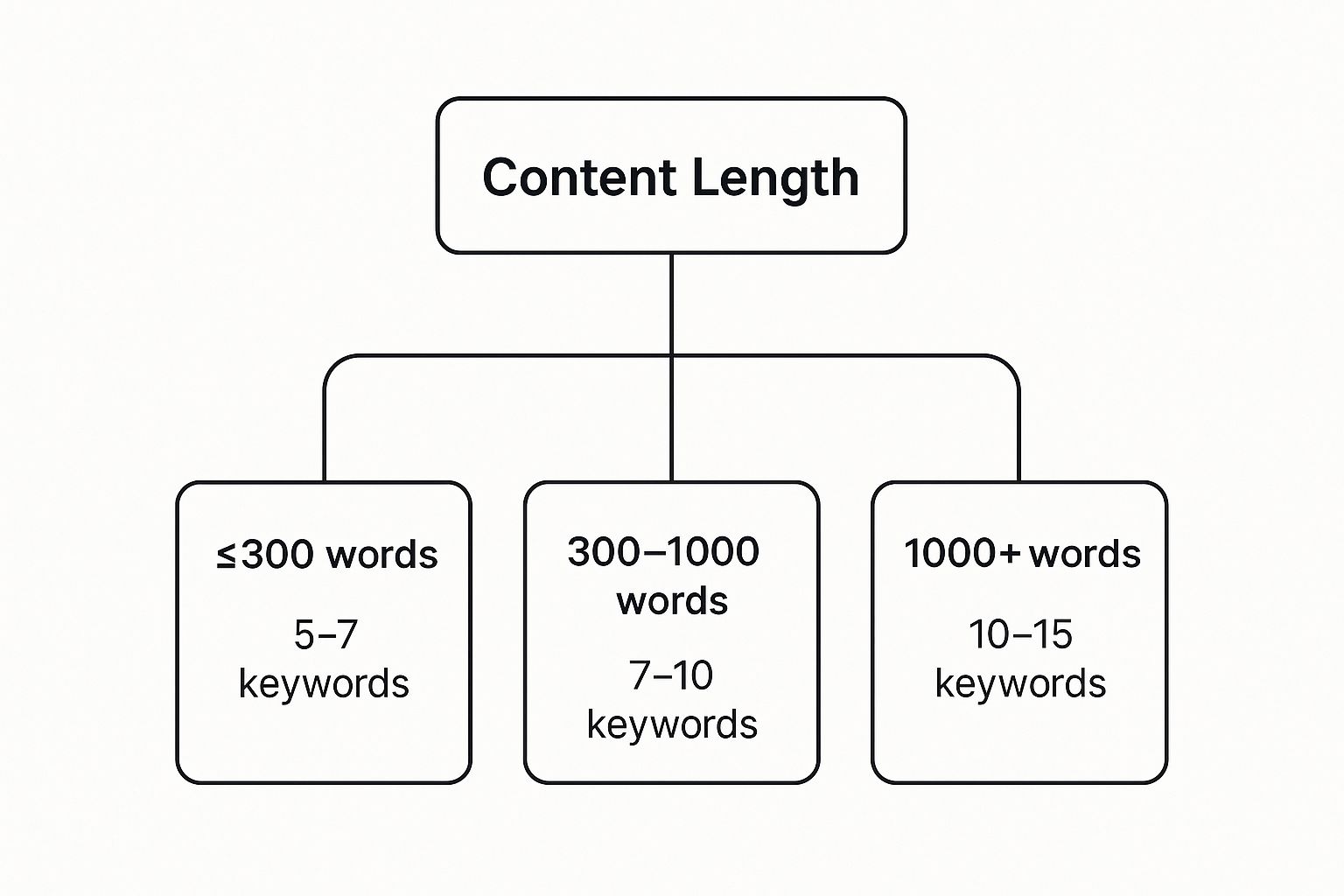
SEO How Many Keywords Per Page A Modern Guide
Share
If you're still wondering "how many keywords should I use on a page," let me reframe the question for you. The modern, and far more effective, answer is to target one primary keyword and then build a universe of related secondary and long-tail keywords around it.
It's all about comprehensive topical coverage, not just hitting some magic number.
The Real Answer to an Old SEO Question

Let's be honest, the whole "how many keywords per page" debate is a holdover from a much earlier era of SEO. A decade ago, the game was often about hitting a specific keyword density, maybe around 1-2%. That mindset is not only outdated today—it can actively hurt your rankings.
Search engines like Google have gotten incredibly sophisticated. They've moved far beyond simply counting how many times you've used a phrase. Now, it's all about understanding the context of your content and the intent behind a user's search. Your content needs to do more than just repeat a keyword; it has to comprehensively answer the question the user didn't even know they were asking.
Think of your page as a single, focused chapter in a book. That chapter should have one clear theme, which is your primary keyword.
The most effective SEO strategy today is to build a page that is the single best resource on the internet for its chosen topic. This is achieved through topical relevance, not keyword repetition.
Of course, to tell a complete story, your main theme needs supporting details. This is where your secondary and long-tail keywords come into play. They act as the supporting paragraphs and finer points that build out the main topic, proving your expertise and building topical authority.
The Evolution from Keyword Density to Topical Relevance
The shift in SEO has been profound. We've moved from a mechanical, numbers-driven approach to a more holistic, user-centric one. This table breaks down the core differences between the old way and the new way of thinking.
| SEO Factor | Outdated Approach | Modern Approach |
|---|---|---|
| Primary Goal | Achieve a target keyword density (1-2%). | Become the most comprehensive resource on a topic. |
| Keyword Focus | Stuffing a single, exact-match keyword. | Using one primary keyword, plus semantic variations and LSI terms. |
| Content Strategy | Writing thin content just to rank for a keyword. | Creating in-depth content that fully addresses user intent. |
| User Experience | Often sacrificed for keyword repetition, resulting in robotic text. | Prioritized to keep users engaged and on the page longer. |
This evolution isn't just a trend; it's a fundamental change in how search engines evaluate and reward content. Focusing on topical relevance is now non-negotiable for long-term success.
Why This Modern Approach Works Better
Adopting this strategy has some serious upsides for your SEO efforts. It’s not just about pleasing Google; it’s about creating genuinely better content.
Here’s why it’s so effective:
- Aligns with User Intent: You're laser-focused on giving users the complete, thorough answers they're actually looking for.
- Builds Topical Authority: By covering a topic from every conceivable angle, you signal to Google that you're a true expert in the field.
- Avoids Over-Optimization: This method naturally prevents the kind of keyword stuffing that makes your content sound robotic and can trigger penalties.
- Improves User Experience: Your content reads naturally and is genuinely helpful, which keeps people on your page longer and encourages them to engage.
Why Keyword Density Is an Obsolete Metric

If you're still painstakingly aiming for a 1-2% keyword density in your articles, you’re basically bringing a flip phone to a smartphone fight. It's a strategy that search engines grew out of years ago, and sticking with it can do more harm than good for your rankings and your readers.
The whole idea of counting keywords is a fossil from a much simpler time online. Back then, search algorithms weren't very sophisticated. Today, however, we have complex systems like Google's BERT and RankBrain that do so much more than count. They actually understand context, synonyms, and the real intent behind a person's search.
When you try to force keywords into your text just to hit a number, the writing almost always sounds robotic and clunky. That's called keyword stuffing, and it’s a one-way ticket to a poor user experience. Worse, it can get you flagged for over-optimization, sending your page plummeting in the search results.
Moving Beyond Simple Repetition
So, if counting is out, what's in? The modern answer to "how many keywords per page" is all about topical coverage, not repetition. Search engines want to see that you're an expert, and you prove that by covering a subject from all angles, not by repeating the same phrase over and over.
Your goal isn't to hit a specific keyword percentage. It's to create the most thorough and genuinely helpful resource you can for someone's query. Always write for the human first.
The data backs this up completely. A recent analysis found the average keyword density for pages in the top 10 results was a tiny 0.04%. That number tells you everything you need to know: search engines are not looking for keyword repetition; they're rewarding depth and value. You can dive deeper into the decline of keyword density as a ranking factor to see just how much things have changed.
At the end of the day, when you focus on serving your reader, you'll naturally use the language and concepts that search engines are built to find. That's the secret to SEO that actually works and lasts.
How to Build Your Page Around a Topic Cluster
The old debate about "how many keywords per page" is officially over. Today, the smart money is on building topical authority, and the best way to do that is with a topic cluster. Think of it less like stuffing a single buzzword into a page and more like creating the go-to guide on a subject.
A topic cluster isn't just a list of terms; it’s a strategic framework built from three core components:
- Primary Keyword: This is your North Star—the main theme of the entire page. It’s the broad search term you’re aiming to own.
- Secondary Keywords: These are the major pillars supporting your main theme. They add necessary context and flesh out the important subtopics.
- Long-Tail Keywords: These are the highly specific, often question-based phrases people are actually typing into Google. They address very particular needs and curiosities.
Structuring Your Keyword Cluster
Let's make this real. Imagine you want to write a definitive guide about "indoor vegetable gardening."
That's your primary keyword. It’s the big idea.
Now, you need to think about the major sub-themes someone interested in this topic would want to know. These become your secondary keywords. They might look something like this:
- "best vegetables to grow indoors"
- "indoor gardening kits"
- "DIY indoor garden setup"
Finally, you dig into the nitty-gritty questions your readers have. These are your long-tail keywords, which directly answer specific problems:
- "how much light do indoor vegetable plants need"
- "what is the best soil for indoor vegetables"
- "how to water indoor vegetable garden"
When you weave these together, you're not just targeting keywords; you're creating a comprehensive resource that signals deep expertise to search engines.
Where to Place Your Keywords Strategically
Okay, you’ve got your cluster. Now, where do you put everything? Forget the outdated advice of hitting a 1-2% keyword density. That’s a relic of the past. The modern approach is all about natural integration and satisfying user intent.
Instead of counting percentages, focus on placing your keywords in the spots that have the most impact:
- Page Title and H1 Tag: Your primary keyword absolutely needs to be here. It’s the first signal to both users and Google about your page's purpose.
- Subheadings (H2, H3): Sprinkle your primary and secondary keywords into your subheadings. This not only helps with SEO but also makes your content much easier for people to scan and read.
- Introduction: Mention your primary keyword somewhere in the first 100 words to confirm the topic right away.
- Image Alt Text: Use relevant keywords to describe your images. It’s an easy win for accessibility and SEO.
- Throughout the Body: This is where you let your secondary and long-tail keywords shine. Weave them into your paragraphs naturally, wherever they fit the context and add value for the reader.
This visual gives you a solid idea of how many keywords a page can naturally support based on its word count.

As you can see, longer content creates more room to include a rich variety of keywords without it ever feeling forced or spammy. This is the secret to building content that stands the test of time, and it's a core principle behind learning how to build consistent traffic growth through Google updates.
Finding the Right Keywords for Your Topic Cluster

Smart keyword research isn't just about chasing high search volumes anymore. The real game is figuring out what people are actually trying to accomplish and then building a topic cluster that makes your page the go-to resource. This all starts with nailing down your primary, secondary, and those super-valuable long-tail keywords.
Modern SEO tools are your best friend here. In 2025, the focus has shifted dramatically toward long-tail keywords, user intent, and how concepts relate to each other—not just how many times you can stuff a keyword onto a page. Tools like Google Keyword Planner, SEMrush, and AnswerThePublic are great because they now bake semantic data and user behavior right into their analysis.
Uncovering Insights Directly from Google
While specialized tools are fantastic, don't overlook the goldmine of keyword intelligence right in front of you: Google's own search results. Pay close attention to the "People Also Ask" (PAA) boxes and the "Related searches" at the bottom of the page.
These features give you a direct peek into the minds of your audience. They show you the exact follow-up questions and related ideas people have after their initial search. Every single one of those questions is a potential long-tail keyword—and a perfect subheading for your next article.
Think of it this way: by mapping each keyword and user question you find to a specific subtopic in your outline, you ensure every single sentence has a job to do. Your blog post stops being just a post and becomes a complete, satisfying answer for the searcher.
Take a look at this "People Also Ask" box from a Google search results page.

Each question highlights a specific need you can solve, making your content more comprehensive and authoritative. Weaving these into your article boosts its relevance and is a killer tactic for any content strategy, especially in niche industries, which we touch on in our guide on what local SEO is.
Putting It All Together: A Keyword Cluster in Action
Alright, let's move from theory to a real-world scenario. Imagine you run a coffee supply company and want to create the ultimate guide to making cold brew. Your main target keyword is, naturally, "cold brew coffee recipe." This is the north star for your entire article.
Now, think about what someone searching for that recipe actually needs to know. They aren't just looking for a list of ingredients. They have questions about the process, the beans, and the equipment. These related ideas are where your secondary and long-tail keywords come into play.
Building Out the "Cold Brew" Cluster
After a bit of research using a tool like Ahrefs or just exploring Google's "People also ask" section, you'd likely end up with a keyword group that looks something like this:
- Primary Keyword: cold brew coffee recipe
-
Secondary Keywords:
- best coffee for cold brew
- cold brew ratio
- coarse ground coffee for cold brew
-
Long-Tail Keywords (often questions):
- how long to steep cold brew coffee
- can you use fine ground coffee for cold brew
- what does cold brew coffee taste like
See how they're all part of the same conversation? This isn't just a random list; it's a content roadmap.
From Keyword List to Content Outline
With this cluster in hand, mapping it to a blog post outline becomes incredibly intuitive. You're no longer stuffing keywords. Instead, you're using them to build a logical flow that answers every potential question a reader might have.
Here’s what that outline could look like:
H1: The Only Cold Brew Coffee Recipe You'll Ever Need
H2: It All Starts with the Beans: Finding the Best Coffee for Cold Brew
- Here, you'd talk about different roasts and origins, naturally weaving in this secondary keyword.
H2: Getting the Proportions Right: The Perfect Cold Brew Ratio
- This section is dedicated to coffee-to-water measurements, making this keyword the star of the show.
H3: Don't Skip This Step: Why You Need Coarse Ground Coffee
- A perfect spot to get a little more technical and address another key search term.
H2: Common Cold Brew Questions
- You can use your long-tail keywords as direct subheadings here, like "How Long Should You Steep Cold Brew Coffee?" or "Can You Use Fine Ground Coffee for Cold Brew?"
This structure shows how a single, comprehensive page can easily target 7 or more closely related keywords. The focus is on the topic, not hitting some magic number. This is how you create content that both users and search engines love.
Common Questions About Keyword Usage
Even with a solid plan, it's easy to get stuck on the practical details of using keywords. Getting these common questions answered can help you sidestep old, outdated habits and really understand what works today. Let's clear up a few things.
Can I Target Multiple Primary Keywords?
This is a classic question, and while it's tempting, the answer is almost always no. You should stick to one primary keyword per page.
Think of your page as having one main job. Trying to make it do two jobs at once—like targeting "commercial refrigerators" and "ice machines" on the same page—just confuses Google and, more importantly, your reader. The content ends up being too general to satisfy anyone searching for either term.
Instead, pick the single best keyword that captures the page's core purpose. You'll naturally rank for all sorts of related terms anyway, so let those be your secondary keywords that add depth and context.
How Do I Know If I Used Too Many Keywords?
There's a surprisingly simple test for this: read your content out loud. Does it sound like a robot? Are you repeating the same clunky phrase over and over? If it feels unnatural to say, you've probably gone too far.
The goal is to write for a human, not a search engine. If your keywords feel like they belong in the sentences and the whole piece flows smoothly, you're doing it right. Google got smart a long time ago and can easily spot keyword stuffing.
Always put readability and user experience first. If you do that, the search engines will reward you.
Does Content Length Affect Keyword Usage?
It absolutely does, but maybe not how you'd expect. It’s not about having more space to cram in keywords. Longer content simply gives you more room to explore a topic thoroughly.
A comprehensive, 2,000-word guide on a topic will naturally include a wider variety of related terms and long-tail phrases than a quick 500-word blog post. You’re answering more questions and covering more subtopics, so those extra keywords show up organically.
This is how you build true topical authority and start pulling in more what is organic traffic. The focus is on creating value, not just hitting a word count.
At Restaurant Equipment SEO, we specialize in creating content that builds authority and drives qualified traffic. Ready to see what a modern SEO strategy can do for your business? Explore our services.